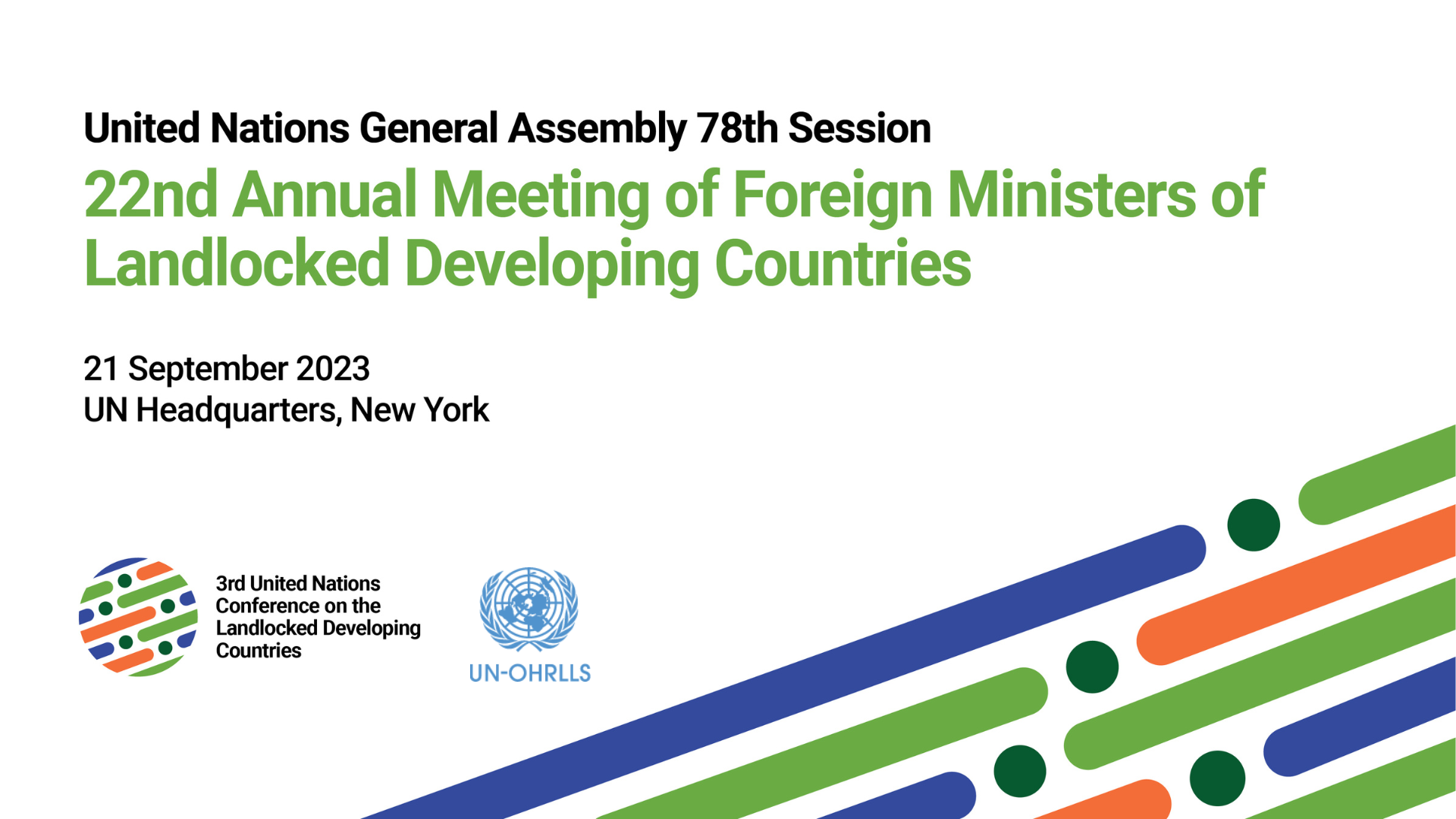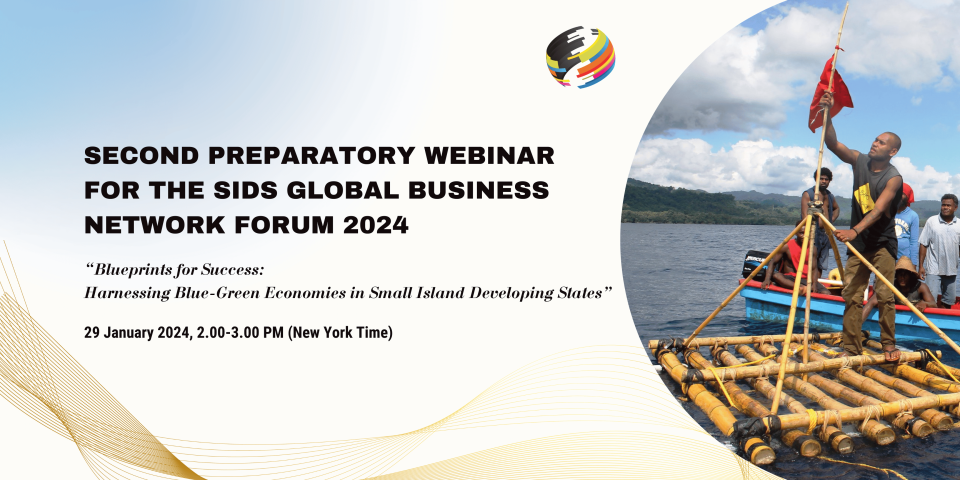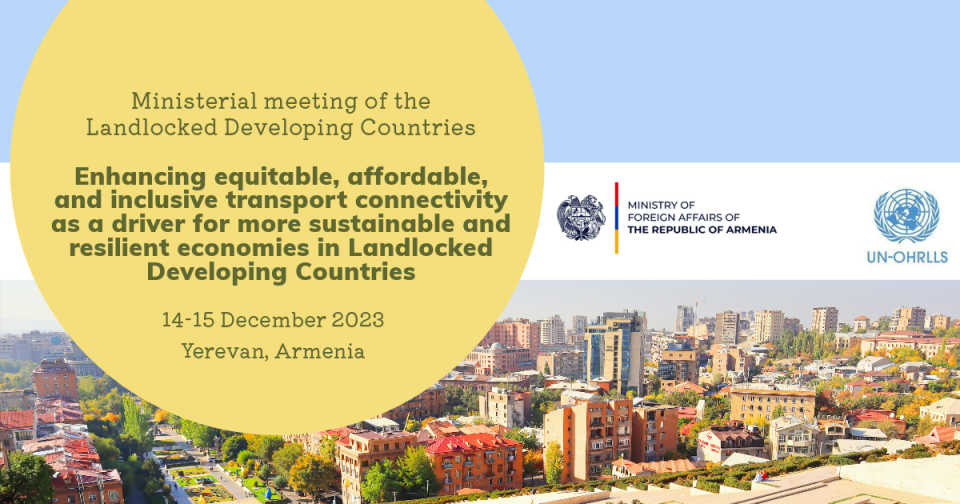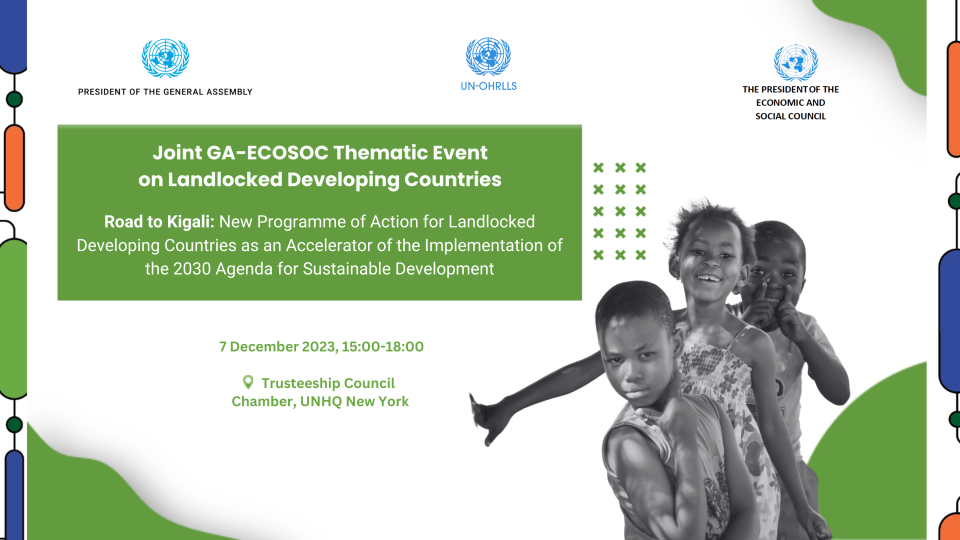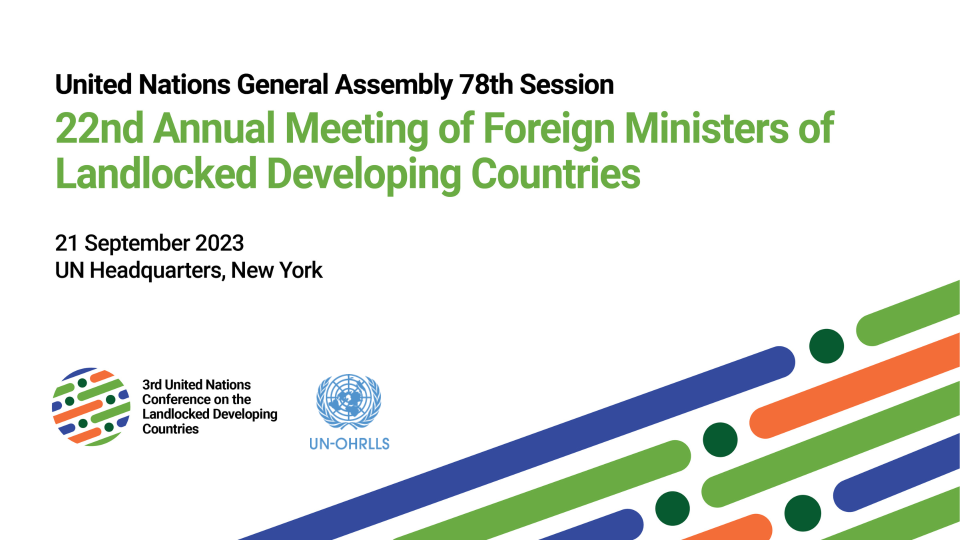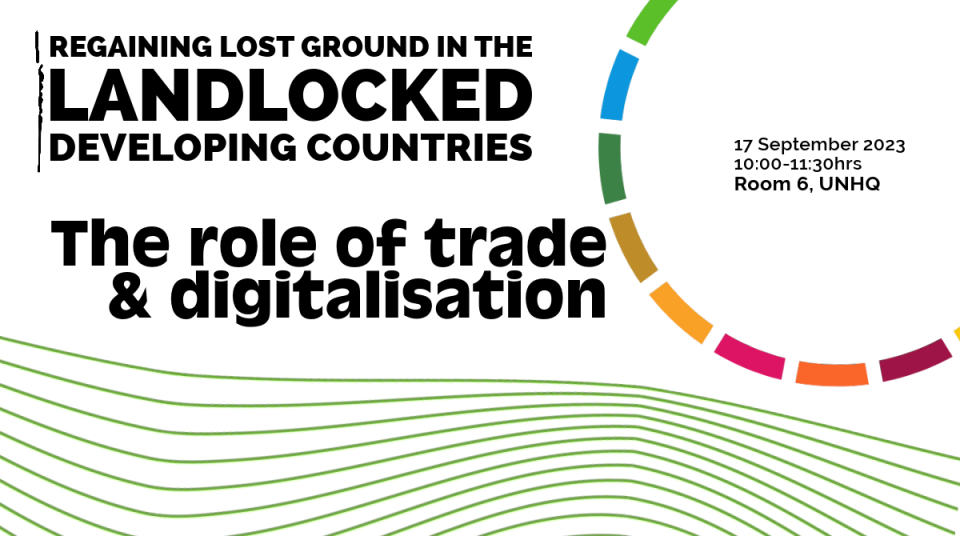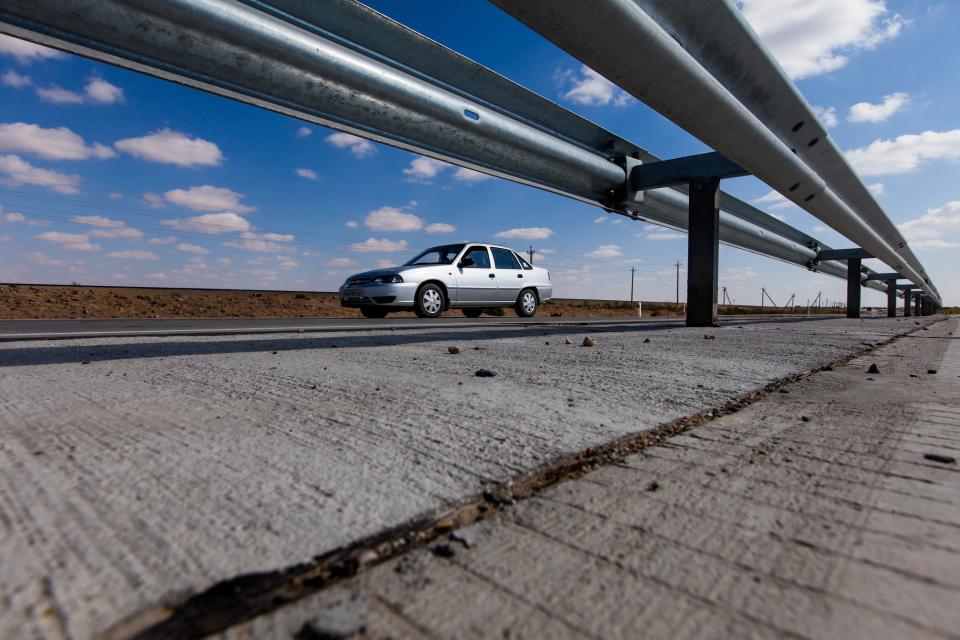22nd Annual Ministerial Meeting of Foreign Ministers of Landlocked Developing Countries
From Vienna to Kigali: Building momentum towards a new decade of action for prosperity and transformation of LLDCs
Background
The United Nations General Assembly (UNGA), in its resolutions 76/217 and 77/246, decided to convene the Third United Nations Conference on Landlocked Developing Countries (LLDC3) in 2024. The Conference aims to undertake a comprehensive review of the implementation of the Vienna Programme of Action for LLDCs for the Decade 2014-2024 (VPoA) and to formulate and adopt a renewed framework for international support to address the special needs of LLDCs and to strengthen partnerships between the LLDCs and transit countries and their development partners. This year’s Annual Ministerial Meeting of Foreign Ministers of LLDCs is being organized as a pre-conference event and is intended to provided inputs to the outcome of the Conference.
Progress in the implementation of the Vienna Programme of Action
Over the last nine years, progress towards meeting the goals and specific objectives of the VPoA has been mixed. The midterm review of the implementation of the VPoA held in 2019 revealed that some progress had been achieved in some areas in the implementation of the VPoA; however, more needed to be done by various stakeholders to enhance the prospects of fulfilling the objectives of the programme. The last half of the implementation period of the VPoA was marked by the devastating impacts of the COVID-19 pandemic that stalled or reversed socio-economic development gains that had been achieved by LLDCs. The fragile recovery from the COVID-19 pandemic has further been disturbed by the challenging global macroeconomic conditions resulting in the exacerbation of their structural and geographical vulnerabilities. The tepid global economic growth, rising inflation and interest rates, the protracted war in Ukraine, supply chain disruptions and elevated food and fuel costs and the exacerbating impacts of climate change are all compounding LLDCs’ trade and transit related vulnerabilities.
According to UNDESA the GDP growth rate for the LLDC group on average dropped from about 6.8% during the period 2000-2014 to an estimated average of 3.4% between 2015 and 2023. It tumbled to -1.2% in 2020 due to the COVID-19 pandemic. It increased to 4.6% in 2021 and was estimated to be 3.6% in 2022.
Inflation in LLDCs has been on the rise since the adoption of the VPoA. High and rising interest rates pose significant debt sustainability risks to several LLDCs with large external debt burdens. Poverty levels in LLDCs have declined but are still higher than the world average. According to World Bank data, poverty headcount ratio at $2.15 a day as a percentage of population was 33.4% over the period 2010-2013 and declined to 29.5% over 2014-2019. Food insecurity worsened in LLDCs during the review period. The prevalence of moderate or severe food insecurity in LLDCs’ total population increased from 43.4% in 2015 to 57.9% in 2022, according to the FAO. LLDCs are significantly affected by climate-induced hazards and disasters such as desertification, recurrent droughts, biodiversity loss, melting glaciers and floods.
A review of the VPoA priorities areas indicate that some progress was achieved in some areas, and some have either been stagnant of regressed. On transit policy issues, some progress was attained on the ratification and implementation of key international conventions to promote trade and transport facilitation. There has also been significant development of regional, sub-regional and multilateral initiatives to support transit.
Some progress has been made in completing missing links and generally improving the quality of infrastructure for increased connectivity of LLDCs, but challenges remain. Several highway networks and railway lines were commissioned in LLDCs during the review period. The COVID-19 pandemic however affected the progress as some LLDCSs diverted investment meant for transport infrastructure development towards the fight against COVID-19. Air traffic in LLDCs, measured in registered carrier departures, increased by 16% from 2014 to 2019 but also suffered the drastic impact of COVID-19 pandemic plunging by 43% in 2020.
The average proportion of population with access to electricity in LLDCs increased from 49.5% in 2014 to 60.3% in 2021 but LLDCs still lag behind the world average of 91.4%. The proportion of individuals using internet in LLDCs also increased from 17.4% in 2014 to 32.3% in 2021 but remains way below the world average of 63.1%. The LLDCs continue to face high costs for broadband, and more efforts are required to lower prices.
LLDCs participation in global trade remain relatively low as both their share of merchandise exports and their share of services exports did not show any significant changes since the adoption of the VPoA. LLDCs merchandise exports in global trade has fluctuated around 1% since the adoption of the VPoA. The impact of COVID-19 led to a significant drop of about 11% in LLDCs’ merchandise exports in 2020. This significant drop demonstrated the fragility of LLDCs’ position in world trade. Consequently, LLDCs suffered a 36% decline in services exports in 2020. Whilst LLDCs trade continues to recover, their share in global trade remains low.
LLDCs continue to undertake measures to reduce their high trade costs by undertaking trade facilitation reforms but more remains to be done. The implementation of the WTO TFA remains low amongst LLDCs compared to transit countries and developing countries averages. On average LLDCs have fully implemented about 35% of the WTO TFA measures compared to 51% by transit countries and 60% for developing countries.
Participation of LLDCs in regional integration increased since the adoption of VPoA from 3.3 in 2014 to 4.3 in 2023. Despite the increased participation of LLDCs in RTAs, implementation remain a challenge. Some arrangements have remained dormant and have been less effective in boosting trade and investment.
LLDCs have made very limited progress towards achieving structural transformation since the adoption of the VPoA. LLDCs’ export structure is still characterized by a strong dependence on primary commodities. In 2021, primary commodities accounted for 83% of merchandise exports from LLDCs against the world average of 28%. In 26 out of the 32 LLDCs, commodities account for more than 60% of their exports.
Mobilization of external resources mobilization towards LLDCs has been insufficient and was greatly affected by the COVID-19 pandemic. ODA flows to LLDCs increased since 2014, but it is concentrated on a few LLDCs. Foreign Direct Investment (FDI) flows to LLDCs declined from US$28.9 billion in 2014 to US$22 billion in 2019 and the COVID-19 pandemic led to a further and severe decline of 35% in 2020. Although FDI inflows recovered in 2021, this recovery was below both the global and developing country average increase. FDI inflows have largely been towards extractive industry, with limited investment inflows in manufacturing and services. Remittances flows to LLDCs increased by 43% between 2014 and 2022. External borrowing, which is an important source of financing is greatly impacted by debt situation in some of the LLDCs. Eight LLDCs have a high risk of distress and three are already in distress.
Documents
- Ministerial Declaration
- Vienna Programme of Action for the Landlocked Developing Countries for the Decade 2014-2024
- 2023 Report of the Secretary-General on the Implementation of the Vienna Programme of Action
- Updated UN Roadmap for Accelerated Implementation of the Vienna Programme of Action for LLDCs in the Remaining Five Years
- GA resolution A/RES/76/217 on the Follow-up to the second United Nations Conference on LLDCs
- GA resolution A/RES/77/246 on the Follow-up to the Second UN Conference on LLDCs Scaling Up
- Report of the 2022 Annual Meeting of Foreign Ministers of Landlocked Developing Countries
- Outcomes of the three Regional Review Meetings on the implementation of the VPoA:
Statements
OPENING SESSION
- Remarks by H.E. Ms. Paula Narvazez Ojeda, President of Economic and Social Council (ECOSOC)
- Remarks by Mr. E. Courtenay Rattray, Chef de Cabinet on behalf of the United Nations Secretary General
BRIEFING ON PROGRESS IN IMPLEMENTING THE VIENNA PROGRAMME OF ACTION FOR LLDCS AND ON PROGRESS TOWARD THE PREPARATIONS FOR THE THIRD UN CONFERENCE ON LLDCS (LLDC3)
GENERAL DEBATE
- Statement by Azerbaijan
- Statement by Kazakhstan
- Statement by Kyrgyzstan
- Statement by Lao PDR
- Statement by Lesotho
- Statement by Mali
- Statement by Nepal
- Statement by Paraguay
- Statement by Uganda
- Statement by Zimbabwe
Objectives
The key objectives of the Ministerial Meeting include the following:
- Review the progress made in the implementation of the Vienna Programme of Action, the 2030 Agenda for Sustainable Development as well as the Roadmap for the Accelerated Implementation of the VPoA, identify challenges faced and share knowledge, experiences and innovative approaches to addressing the challenges;
- Identify appropriate policy measures and concrete action-oriented recommendations at the national, regional and global levels necessary for making the next programme of action for LLDCs a truly transformative one;
- Build political momentum to fully engage in the whole process of LLDC3.
Expected Outcome
The meeting will provide a platform for LLDCs to engage at political level and build momentum towards the third UN Conference on LLDCs. The Ministerial Meeting will, amongst others, reinforce the political commitment to a productive and successful Conference in Kigali in 2024.
The meeting will adopt an outcome document with recommendations for the preparations of the Third United Nations Conference.
The meeting will also contribute to the discussions of the 78th session of the UN General Assembly. The meeting will adopt a Ministerial Declaration.
Participation
The Ministerial Meeting will be attended by Ministers and High-Level officials from the 32 LLDCs. Ministers and High-Level Officials from transit developing countries, development partners and high-level representatives of the UN system and other international and regional organizations will also be invited to participate.


